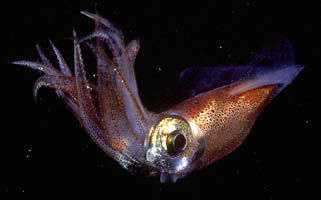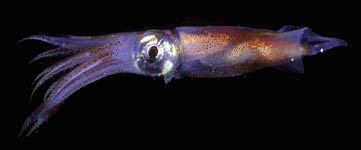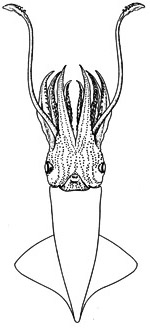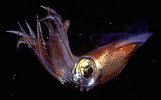Abralia veranyi
Kotaro TsuchiyaIntroduction
A. veranyi is the most widely distributed Abralia species in the Atlantic Ocean. This species is characterized by having five eye photophores of two types, 3-4 hooks on each tentacular club, and the left ventral arm hectocotylized.Characteristics
- Tentacle clubs
- Two or three hooks on ventral side.
- Two rows of large suckers on dorsal side of manus.
 image info
image info
- Hectocotylus
- Left ventral arm of male hectocotylized.
- Hectocotylus with two different sized off-set flaps.
 image info
image info
- Eye Photophores
- Five complex organs: two large terminal opaque organs with three small silvery organs between them.
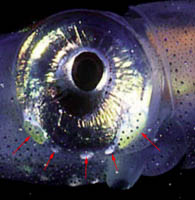 image info
image info
- Integumental Photophores
- Ventral mantle and head with scattered arrangement of integumental organs.
Distribution
Vertical distribution
Two juvenile specimens were caught in daylight at 700-800m deep and in night at 60-20m in 10° N, 20° W by midwater tow (Lu & Clarke, 1975)Geographical distribution
This species was first described from the Mediterranean Sea (Ruppell, 1844). It is the most widely distributed member of the Atlantic Abralia species associated with the distant-neritic waters. Distribution were known from the northern Sargasso Sea to northern Brasil in West Atlantic, and south off France to Benguella water in East Atlantic.References
Fischer, H. 1896. Note préliminaire sur le Pterygioteuthis Giardi, céphalopode nouveau recuelli dans le Cours de l'Expédition scientifique du Talisman (1883). Jour. Conchyliologie 43: 205-211.
Hoyle, W. E. 1904. Reportson the Cephalopoda. Bull. Mus. Comp. Zool., Harvard Coll, Cambridge. 43: 1-72.
Nesis, K. N. 1982. Abridged key to the cephalopod mollusks of the world's ocean. 385+ii pp. Light and Food Industry Publishing House, Moscow. (In Russian.). Translated into English by B. S. Levitov, ed. by L. A. Burgess (1987), Cephalopods of the world. T. F. H. Publications, Neptune City, NJ, 351pp.
Okutani, T. 1974. Epipelagic decapod cephalopods collected by micronekton tows during the EASTROPAC expeditions, 1967-1968 (systematic part). Bull. Tokai Reg. Fish. Res. Lab., 80: 29-118.
Pfeffer, G. 1912. Die Cephalopoden der Plankton-Expedition. Ergebnisse der Plankton-Expedition der Humboldt-Stiftung. 2: 1-815.
Roper, C. F. E. and R. E. Young. 1975. Vertical distribution of pelagic cephalopods. Smithsonian Contributions to Zoolog, 209: 1-51
Young, R. E. 1978. Vertical distribution and photosensitive vesicles of pelagic cephalopods from Hawaiian waters. Fishery Bulletin, 76: 583-615.
Young, R. E. 1995. Aspects of the natural history of pelagic cephalopods of the Hawaiian mesopelagic-boundary region. Pac. Sci. 49: 143-155.
Young, R. E., K. M. Mangold and M. Vecchione (1992). The enoploteuthid group of families. P. 55-66. In: Sweeney, M. J., C. F. E. Roper, K. M. Mangold, M. R. Clarke and S. V. Boletzky (eds.). "Larval" and juvenile cephalopods: a manual for their identification. Smithson. Contr. Zool., No. 513: 1-282.





